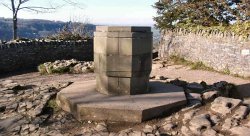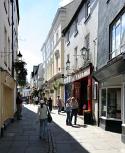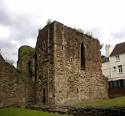Road from Ross on Wye to Monmouth
Leaving Ross by the A40 Monmouth Road it is possible to access many places of interest.
 Just 5 miles south of Ross is Goodrich
Castle, once the home of the Earls and Dukes of
Kent and the Earls of Shrewsbury it was effectively dismantled following the civil war
but is still considered to be one of the most complete medieval strongholds in Britain. Just 5 miles south of Ross is Goodrich
Castle, once the home of the Earls and Dukes of
Kent and the Earls of Shrewsbury it was effectively dismantled following the civil war
but is still considered to be one of the most complete medieval strongholds in Britain.
From its strategic position superb views over the Wye
Valley are
to be observed, visitors have the opportunity to climb the battlements and to explore its
passageways and rooms.
Free audio tours are available and give an insight into the castles past.
 Travelling further along the A40 is the beautiful and ever popular Symonds Yat. Travelling further along the A40 is the beautiful and ever popular Symonds Yat.
The name originates from Robert Symonds a 17th Century Sheriff of Herefordshire and the Yat part of the name from the local name for a gate or pass.
Facilities for visitors are amply provided and cater for most peoples needs and tastes
with its restaurants and hotel .
Also on the west side of the river there is a puzzle shop, a maze and museum, here it is possible to learn how to make mazes and to explore myths.
Open daily throughout the year with the exception of Xmas day and New year it has proved to be a popular attraction.
See the ancient hand-pull ferry this has proved to have a nostalgic appeal in these modern times.
 Also signposted of the A40 road at Symonds Yat is the Wye
Valley Butterfly Zoo, here the visitor can see a large collection of Butterflies and Moths, these beautiful
colourful creatures originate from the America’s, Africa and Asia . Also signposted of the A40 road at Symonds Yat is the Wye
Valley Butterfly Zoo, here the visitor can see a large collection of Butterflies and Moths, these beautiful
colourful creatures originate from the America’s, Africa and Asia .
In and around the river a whole range of activities are available for those wishing to be involved .
There is rock
climbing, canoeing and other water sports.
 For the less energetic a River Cruise might hold more appeal, Kingfisher Cruises are based at Symonds Yat east , to get there follow the A40 towards Monmouth and then take the A 4136 continue and follow the Kingfisher Signs. For the less energetic a River Cruise might hold more appeal, Kingfisher Cruises are based at Symonds Yat east , to get there follow the A40 towards Monmouth and then take the A 4136 continue and follow the Kingfisher Signs.
Whilst on this side of the Wye visit Symonds Yat Rock it is well worth a visit .
 Follow the A4228 and then the signs marked accordingly. Follow the A4228 and then the signs marked accordingly.
Symonds Yat Rock is situated in the upper Wye gorge and the views from the rock are a delight with its stunningley high aspect over the river. This once Iron Age hill fort is nearly 400ft above the river.
 Peregrine
Falcons nest here and it is possible to watch what is the fastest bird in the world
swoop and soar whilst hunting for prey. During the months April to August each year they
raise their young. There is a Peregrine viewing point run by a joint partnership of
the Forestry Commission and the R.S.P.B. these provide staff and volunteers to assist
and advise visitors. Equipped with telescopes and binoculars they allow visitors to use
these to view the nests. Peregrine
Falcons nest here and it is possible to watch what is the fastest bird in the world
swoop and soar whilst hunting for prey. During the months April to August each year they
raise their young. There is a Peregrine viewing point run by a joint partnership of
the Forestry Commission and the R.S.P.B. these provide staff and volunteers to assist
and advise visitors. Equipped with telescopes and binoculars they allow visitors to use
these to view the nests.
Looking down on the river it is hard to believe that these tranquil waters was at one time a commercial waterway on which boats carried ore, coal, timber and charcoal.
Fallow Deer roam the surrounding woodlands as do Badgers and Foxes and on the river Otters are at home in this most suitable habitat.
It is possible to obtain light refreshments at a cabin which is open every day during the summer months and at weekends during the winter.
The car park and toilets open at 10am and close at 8-30pm or at dusk if sooner.
Monmouth
This ancient Welsh town can be reached via& the A40 road from Ross
its Welsh name is Trefynwy.
In Roman times it was known as Blestium and much evidence of the towns occupation by the Romans has been found. It was also governed by the Normans after the conquest. 
Standing at the junctions of the river Monnow and the river
Wye the small town attracts many visitors.
With its unique 13th century gated stone bridge it is regarded as the only preserved bridge
of its style and design in Britain.
The town was no longer considered to be a market town following the
demolition of its cattle market to make way for a new bridge over the River Monnow.
The Farmers Market is still a feature in the town and local produce can be purchased.
Each year the Monmouth show is held and usually it is held on the last Thursday
in August.
The origins of the show go back to 1857 when the eighth Duke of Beaufort and Sir Charles Morgan MP provided the finance to found the Monmouth Cattle Show.
In earlier years there had been an agricultural society this was in the late 1700s.
It was in recent years that important Roman remains were found, a site
was being cleared for build retail premises when evidence by way of artefacts
were discovered.
Construction of new premises was delayed until the site was fully excavated. The delay
went on for some years.
After all finds and details were catalogued the site was filled in and is now built upon.
There is quite a wide variety of shops and a selection of places to eat and drink.
For those that are interested there are museums that can be visited free of
charge
These contain quite a number of items are of historical value and interest.
One of the museums at Monmouth Castle which was built in Norman times
by William  Fitzosbern a Nephew of William the Conquerer. Fitzosbern a Nephew of William the Conquerer.
At that time it was a castle of considerable importance and in a strategic position but
it is now a ruin along with the castle house. The Royal Monmouthshire Royal Engineers
(not an error in the title) museum is sited here, run by volunteers this little museum
has many items to interest visitors , entry is free but donations are gladly accepted.
The Nelson
Museum & Local History Centre is well worth a visit entry here is
also free. Situated in Priory Street with parking nearby it has many exhibits on
view.
In the local history centre there is Archaeology, Archive material, coins and medals, items connected with industry , transport& and weapons of war and Henry V’s connection with the town.
In the section devoted to Admiral Lord Nelson there is much to see, this
includes a large number of personal letters , Nelsons fighting sword and some counterfeit
material that is very obvious that it is fake, one item is claimed to be Nelsons glass
eye.
The museum was founded in 1924 , this followed a bequest to the town by Lady Llangattock
of material that related to this famous Admiral.
- For more comprehensive information about Monmouth
|